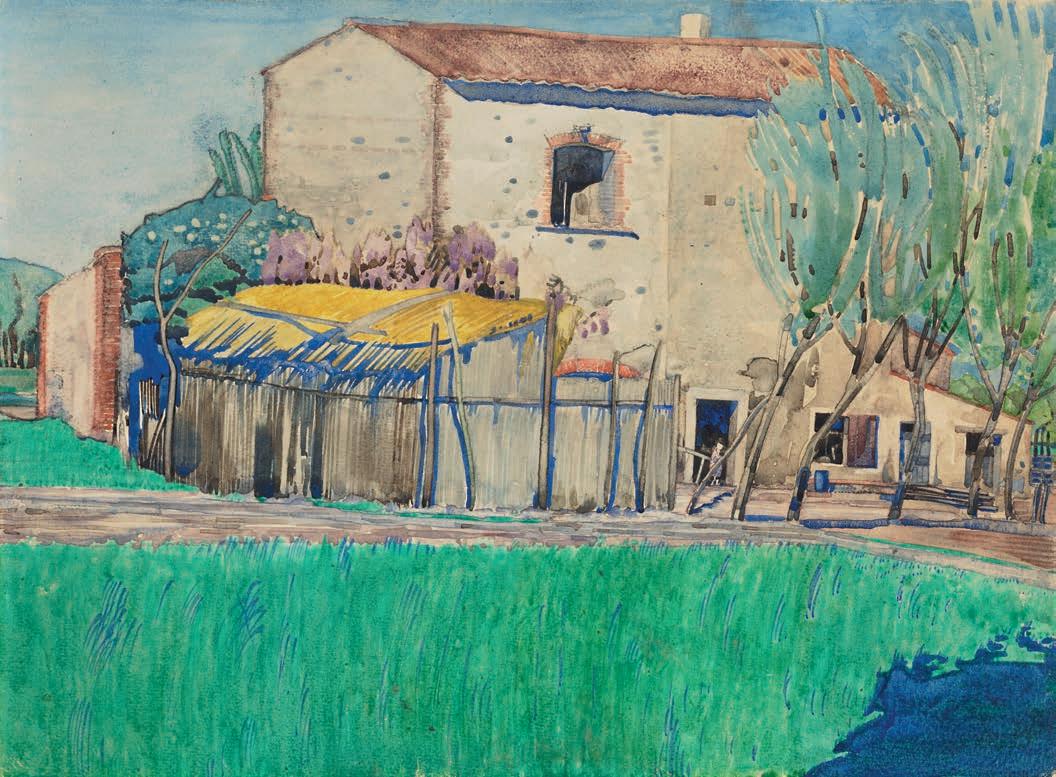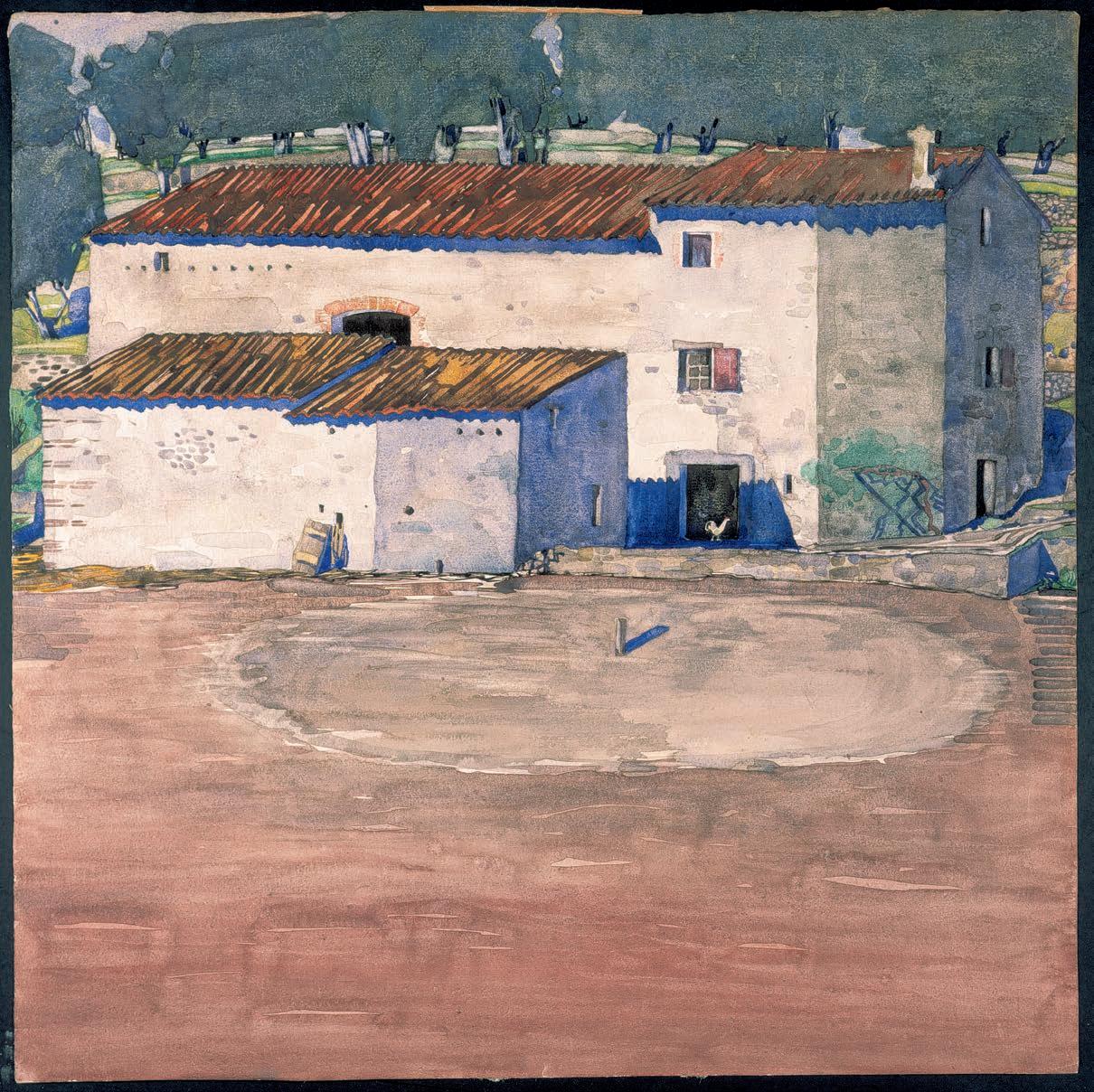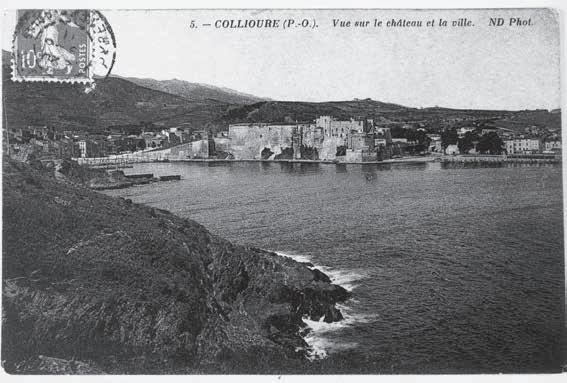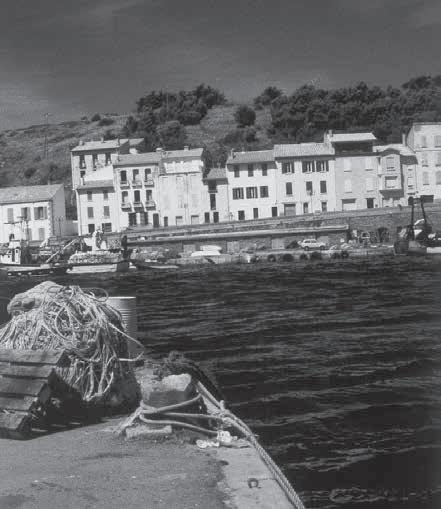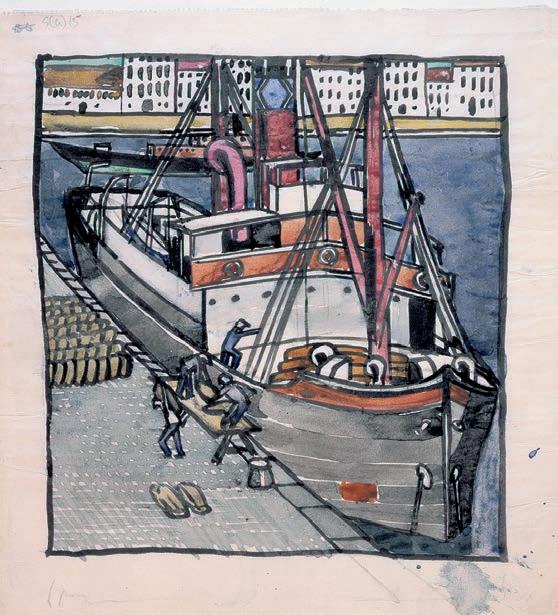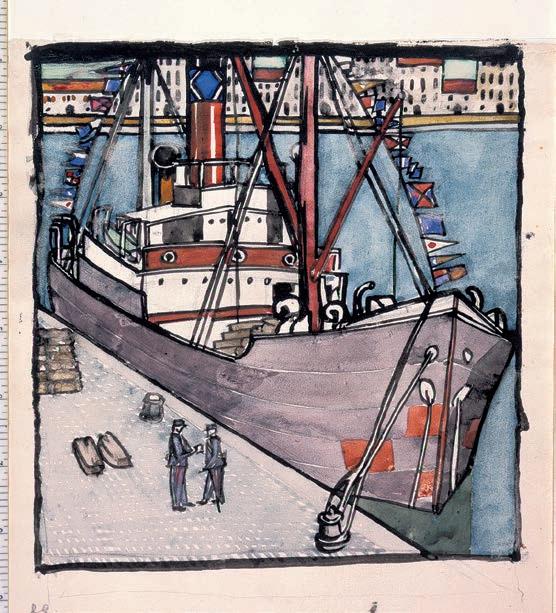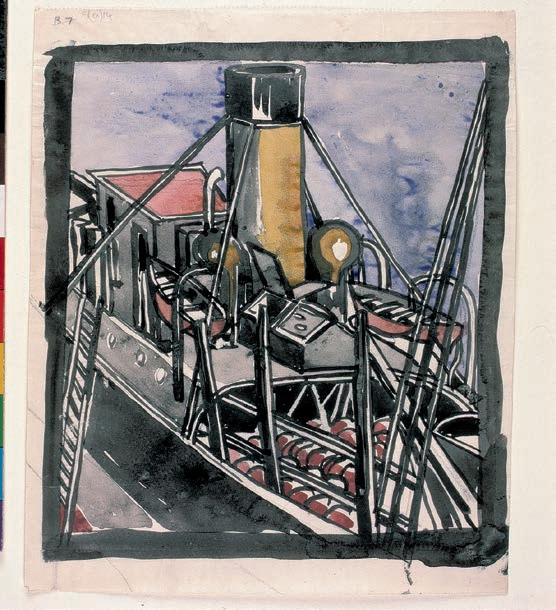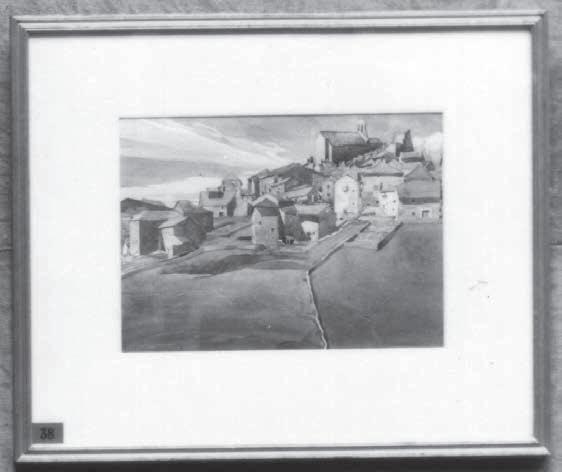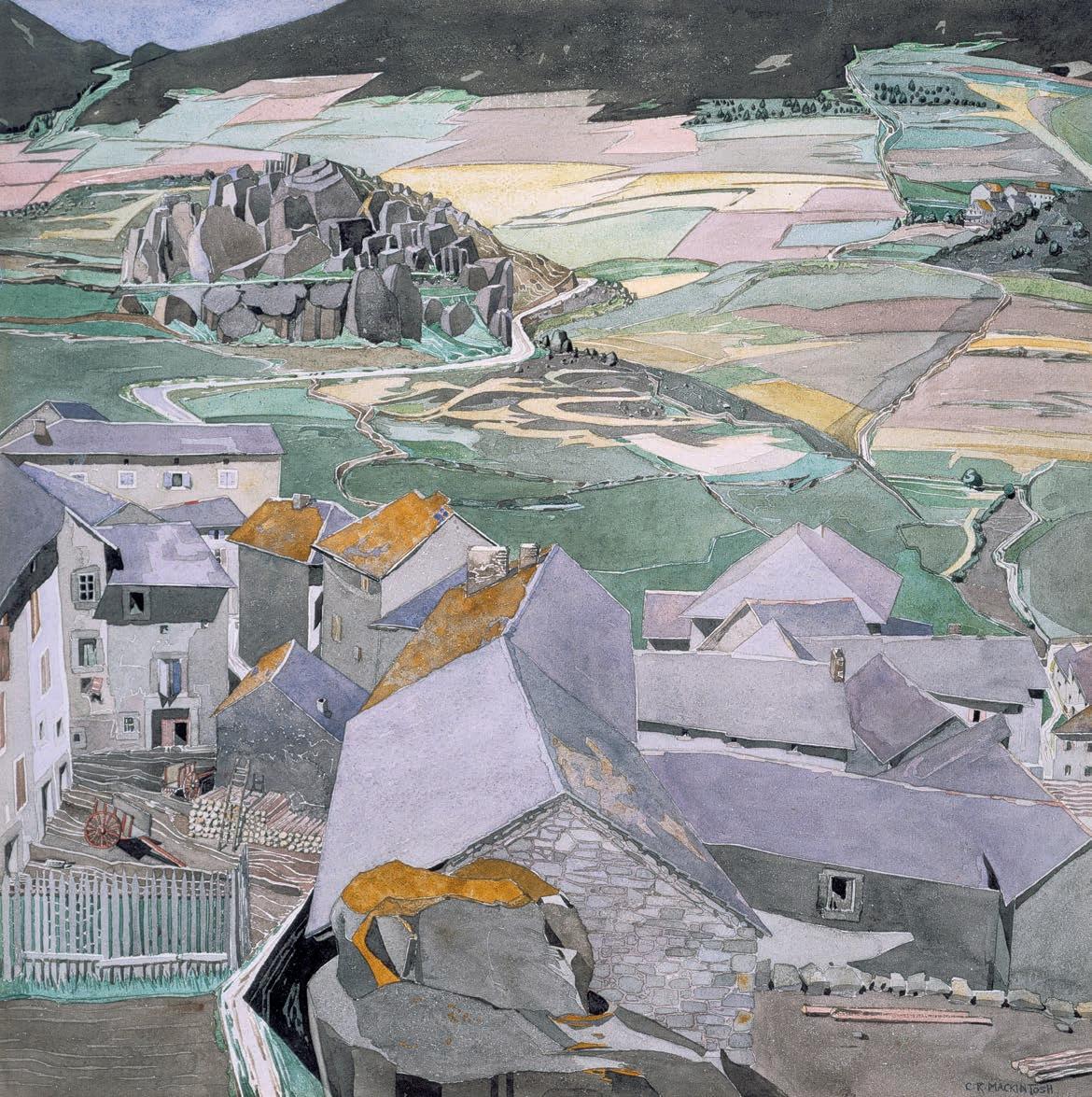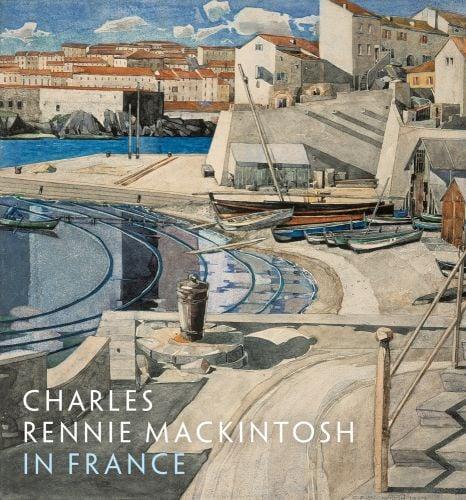
known), connections can be made between this aspect of Mackintosh’s art and the most progressive works of that group. By the late 1880s Arthur Melville’s brilliant, free watercolour technique had inspired many Scottish artists in the use of that medium. The Tree of Influence may represent a quite di^erent, otherworldly view from Melville’s watercolour of 1893, Autumn –Loch Lomond [fig.32], but Mackintosh’s leap beyond Melville’s naturalism is interesting in the context of recent developments in the work of two other Glasgow Boys, George Henry and E.A. Hornel (the latter a close friend of Mackintosh’s employer, John Keppie). By about 1890 and on occasion working collaboratively, they had developed a new phase in their art which is strongly symbolic in content (commonly featuring mythical or sprite-like figures shown intertwined with nature), and so linked directly with the art of Mackintosh, McNair and the Macdonald sisters. A friend and contemporary of Mackintosh’s at Glasgow School of Art was another of the Glasgow Boys, David Gauld, whose St Agnes [fig.33] of 1889 anticipates the elongated symbolist figures of Mackintosh and his associates’ graphic style of the mid-1890s. St Agnes was shown along with other works by the Glasgow School at the Munich International Exhibition of 1890, where their innovative painting contributed to the artistic discord that led to the formation of the Munich Secession in 1893. A stylistic analysis of Gauld’s St Agnes, in particular, his treatment of the landscape and distant village, suggests Mackintosh may have returned to a memory of this work as he formulated his French paintings. This may also have been the case with George Henry’s A Galloway Landscape [fig.34], also painted in 1889 and identified as one of the most
known), connections can be made between this aspect of Mackintosh’s art and the most progressive works of that group. By the late 1880s Arthur Melville’s brilliant, free watercolour technique had inspired many Scottish artists in the use of that medium. The Tree of Influence may represent a quite di^erent, otherworldly view from Melville’s watercolour of 1893, Autumn –Loch Lomond [fig.32], but Mackintosh’s leap beyond Melville’s naturalism is interesting in the context of recent developments in the work of two other Glasgow Boys, George Henry and E.A. Hornel (the latter a close friend of Mackintosh’s employer, John Keppie). By about 1890 and on occasion working collaboratively, they had developed a new phase in their art which is strongly symbolic in content (commonly featuring mythical or sprite-like figures shown intertwined with nature), and so linked directly with the art of Mackintosh, McNair and the Macdonald sisters. A friend and contemporary of Mackintosh’s at Glasgow School of Art was another of the Glasgow Boys, David Gauld, whose St Agnes [fig.33] of 1889 anticipates the elongated symbolist figures of Mackintosh and his associates’ graphic style of the mid-1890s. St Agnes was shown along with other works by the Glasgow School at the Munich International Exhibition of 1890, where their innovative painting contributed to the artistic discord that led to the formation of the Munich Secession in 1893. A stylistic analysis of Gauld’s St Agnes, in particular, his treatment of the landscape and distant village, suggests Mackintosh may have returned to a memory of this work as he formulated his French paintings. This may also have been the case with George Henry’s A Galloway Landscape [fig.34], also painted in 1889 and identified as one of the most
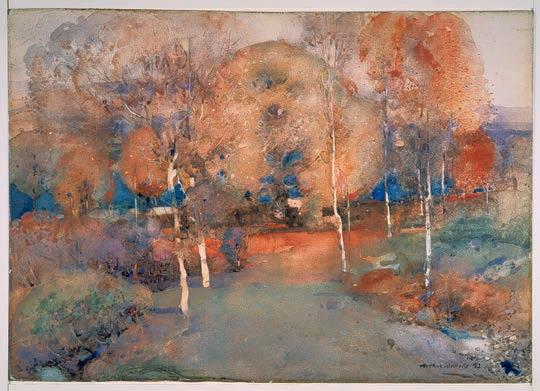
innovative Glasgow School paintings of the period. Henry’s work shows a rural hillside, and while it has many of the characteristics of the Glasgow School’s art of that date – in particular a raking landscape bounded by a high horizon, motifs evident in Mackintosh’s French paintings – Henry’s sinuous, curving river-form recurs in a number of Mackintosh’s inland French subjects. Mackintosh’s depiction of the road that rises up and branches across Mont Alba [plate 5] – painted high up in the deep gorge at Montalba d’Amélie (to the south of Amélie-les-Bains) – provides that work with the same decorative e^ect achieved by Henry, and we find this repeated in the serpentine track climbing through the unknown location of A Hill Town in Southern France [plate 4]
innovative Glasgow School paintings of the period. Henry’s work shows a rural hillside, and while it has many of the characteristics of the Glasgow School’s art of that date – in particular a raking landscape bounded by a high horizon, motifs evident in Mackintosh’s French paintings – Henry’s sinuous, curving river-form recurs in a number of Mackintosh’s inland French subjects. Mackintosh’s depiction of the road that rises up and branches across Mont Alba [plate 5] – painted high up in the deep gorge at Montalba d’Amélie (to the south of Amélie-les-Bains) – provides that work with the same decorative e^ect achieved by Henry, and we find this repeated in the serpentine track climbing through the unknown location of A Hill Town in Southern France [plate 4]
As Mackintosh turned full time to painting in the 1920s, such links with the 1890s may have seemed remote, and if a connection is to be made with the art of the Glasgow School, then a work such as Arthur Melville’s A Sapphire Sea [fig.35], painted on the Spanish coast in 1892, more obviously shares Mackintosh’s interest in the reductive e^ect of strong light on water and buildings. However, Mackintosh’s geometrical, angular design and his use of repeating motifs (done with great contrasting e^ect in the The Little Bay, Port Vendres [plate 17], with its stylised curving waves and zigzag balustrade shadows), makes clear that his French painting is the product of a more modern artistic sensibility, and succeeds the dynamism of his wartime textile designs [fig.37] and the work at Derngate, the Northampton home of W.J. Bassett-Lowke [fig.36].
As Mackintosh turned full time to painting in the 1920s, such links with the 1890s may have seemed remote, and if a connection is to be made with the art of the Glasgow School, then a work such as Arthur Melville’s A Sapphire Sea [fig.35], painted on the Spanish coast in 1892, more obviously shares Mackintosh’s interest in the reductive e^ect of strong light on water and buildings. However, Mackintosh’s geometrical, angular design and his use of repeating motifs (done with great contrasting e^ect in the The Little Bay, Port Vendres [plate 17], with its stylised curving waves and zigzag balustrade shadows), makes clear that his French painting is the product of a more modern artistic sensibility, and succeeds the dynamism of his wartime textile designs [fig.37] and the work at Derngate, the Northampton home of W.J. Bassett-Lowke [fig.36].
The geometric motifs he used in both relate not only to the designs of the Wiener Werkstätte (the design studio and workshops established in Vienna in 1903, to which Mackintosh was con-
The geometric motifs he used in both relate not only to the designs of the Wiener Werkstätte (the design studio and workshops established in Vienna in 1903, to which Mackintosh was con-
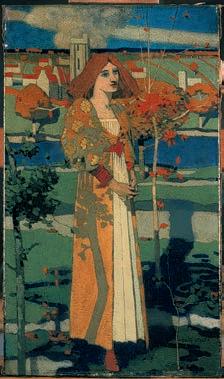
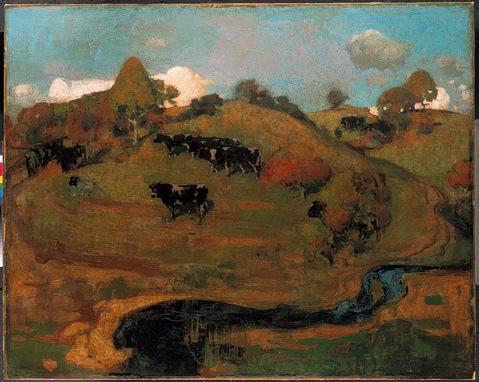
nected), but also to Art Deco. There is much in Mackintosh’s French paintings which recall that diverse aesthetic. The views of Port Vendres, for example, his most frequent subject while in France, commonly use the favourite Art Deco motifs of broad bands or blocks of colour, and geometrical stylisation of natural forms. Finding pattern in nature had been a preoccupation throughout Mackintosh’s career in his work in all media, and his French paintings are no exception; in watercolours such as La Rue du Soleil [plate 16], he must have delighted in the e^ect created by the reflections of quayside buildings, and freely exercised his graphic ability to produce an artwork where his predominant interest has been the visual pattern created by the rippling water.
nected), but also to Art Deco. There is much in Mackintosh’s French paintings which recall that diverse aesthetic. The views of Port Vendres, for example, his most frequent subject while in France, commonly use the favourite Art Deco motifs of broad bands or blocks of colour, and geometrical stylisation of natural forms. Finding pattern in nature had been a preoccupation throughout Mackintosh’s career in his work in all media, and his French paintings are no exception; in watercolours such as La Rue du Soleil [plate 16], he must have delighted in the e^ect created by the reflections of quayside buildings, and freely exercised his graphic ability to produce an artwork where his predominant interest has been the visual pattern created by the rippling water.
In moving to the warm south of France, Mackintosh was in tune with a wider, fashionable belief in the health-giving benefits of the sun, enjoyed away from industrialised cities. This was extensively expressed in the art of the period, most explicitly through Art Deco motifs such as the sunburst. Hand in hand with this was a developing interest in the exotic and the attraction of ‘primitive’ and foreign cultures, which fed design styles of the period. This could be experienced in Port Vendres which, because of its position and its deep-water harbour, was the principal French port for Algeria. Mackintosh clearly enjoyed the busy life of the town and expressed this most poetically in The Chronycle, the series of letters he wrote to his wife while she was in London in 1927.³
In moving to the warm south of France, Mackintosh was in tune with a wider, fashionable belief in the health-giving benefits of the sun, enjoyed away from industrialised cities. This was extensively expressed in the art of the period, most explicitly through Art Deco motifs such as the sunburst. Hand in hand with this was a developing interest in the exotic and the attraction of ‘primitive’ and foreign cultures, which fed design styles of the period. This could be experienced in Port Vendres which, because of its position and its deep-water harbour, was the principal French port for Algeria. Mackintosh clearly enjoyed the busy life of the town and expressed this most poetically in The Chronycle, the series of letters he wrote to his wife while she was in London in 1927.³
Since the 1880s France had been a destination for Scottish artists, but they had tended to centre on Paris until figures such as Melville and then J.D. Fergusson and S.J. Peploe began to explore the Mediterranean coast. Fergusson in particular was one of the
Since the 1880s France had been a destination for Scottish artists, but they had tended to centre on Paris until figures such as Melville and then J.D. Fergusson and S.J. Peploe began to explore the Mediterranean coast. Fergusson in particular was one of the
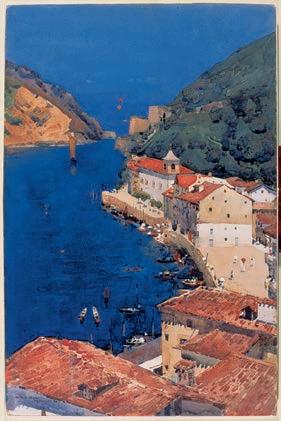
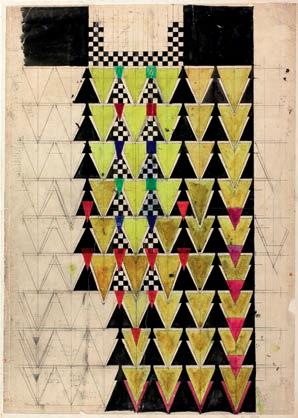
first British artists to come into direct contact with the important artistic developments taking place in France in the first decade of the twentieth century, an experience which transformed his art. From Paris (where he had settled in 1907) Fergusson moved to the French Mediterranean coast, but was forced to return to London at the beginning of the First World War. At the outbreak of hostilities Mackintosh was in Walberswick on the Su^olk coast. His architectural partnership with Honeyman & Keppie had recently been dissolved and he and Margaret had gone to Walberswick on holiday, where he was preoccupied with painting, producing numerous flower studies and a few landscapes [see figs.18–20]. By the following summer the Mackintoshes were in London, settling in Chelsea, close to Fergusson and his partner, the dancer Margaret Morris. There, Morris had established a dance school, which also operated as a social club, soon regularly attended by the Mackintoshes as well as by artists such as Randolph Schwabe, Augustus John, Jacob Epstein and Wyndham Lewis. During the early years of the First World War, in part because of the harsh new order it created, fierce divisions developed between artists that resulted in a cultural period that was both energetic and turbulent. This was exemplified by the exhibition Twentieth Century Art: A Review of Modern Movements, held at the Whitechapel Art Gallery in London in the early summer of 1914. This drew attention to a diversity of grouping including Walter Sickert and the Camden Town Group, the Bloomsbury painters, the rebellious Vorticists (of which Epstein and Lewis were part), and artists such as Stanley Spencer and Mark Gertler. Fergusson and Peploe also took part. If Mackintosh had not seen the exhibition, he must have become
first British artists to come into direct contact with the important artistic developments taking place in France in the first decade of the twentieth century, an experience which transformed his art. From Paris (where he had settled in 1907) Fergusson moved to the French Mediterranean coast, but was forced to return to London at the beginning of the First World War. At the outbreak of hostilities Mackintosh was in Walberswick on the Su^olk coast. His architectural partnership with Honeyman & Keppie had recently been dissolved and he and Margaret had gone to Walberswick on holiday, where he was preoccupied with painting, producing numerous flower studies and a few landscapes [see figs.18–20]. By the following summer the Mackintoshes were in London, settling in Chelsea, close to Fergusson and his partner, the dancer Margaret Morris. There, Morris had established a dance school, which also operated as a social club, soon regularly attended by the Mackintoshes as well as by artists such as Randolph Schwabe, Augustus John, Jacob Epstein and Wyndham Lewis. During the early years of the First World War, in part because of the harsh new order it created, fierce divisions developed between artists that resulted in a cultural period that was both energetic and turbulent. This was exemplified by the exhibition Twentieth Century Art: A Review of Modern Movements, held at the Whitechapel Art Gallery in London in the early summer of 1914. This drew attention to a diversity of grouping including Walter Sickert and the Camden Town Group, the Bloomsbury painters, the rebellious Vorticists (of which Epstein and Lewis were part), and artists such as Stanley Spencer and Mark Gertler. Fergusson and Peploe also took part. If Mackintosh had not seen the exhibition, he must have become
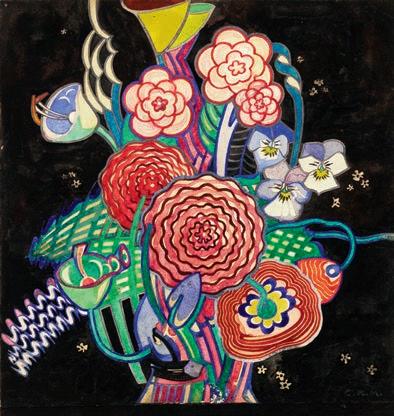
Fig.35 | Arthur Melville
Fig.35 | Arthur Melville
A Sapphire Sea 1892
A Sapphire Sea 1892
Private collection courtesy of Bourne Fine Art, Edinburgh
Private collection courtesy of Bourne Fine Art, Edinburgh
Fig.36 | C.R. Mackintosh
Fig.36 | C.R. Mackintosh
Design for a stencil for the hall of 78 Derngate, Northampton 1916
Design for a stencil for the hall of 78 Derngate, Northampton 1916
Hunterian Art Gallery, University of Glasgow
Hunterian Art Gallery, University of Glasgow
Fig.37 | C.R. Mackintosh
Fig.37 | C.R. Mackintosh
Textile design: Basket of Flowers c.1915–20
Textile design: Basket of Flowers c.1915–20
Hunterian Art Gallery, University of Glasgow
Hunterian Art Gallery, University of Glasgow The Hunterian, University of Glasgow The Hunterian, University of Glasgow

